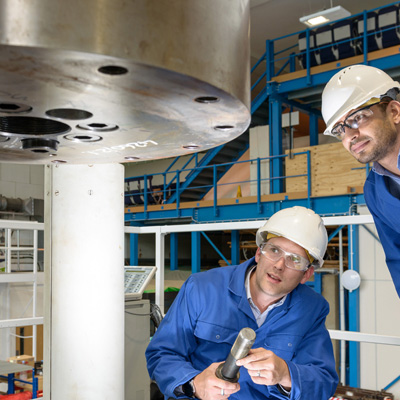Our international reputation, distinctive focus on technology and management, powerful industry links, world-class research and knowledge of what works for business, make Cranfield your ideal academic partner for master’s-level apprenticeships.
When you choose to partner with Cranfield, your staff will benefit from a world-renowned educational offering. Apprenticeship students are integrated with our experienced and international student body and are eligible to join our 80,000-strong worldwide alumni network.
We understand what is needed to develop industry-led apprenticeship standards and have many years' experience of working with postgraduate, experienced learners and their employers.
By offering Cranfield's apprenticeship programmes your company will:
- Be able to offer the opportunity to both early and mid-career employees;
- Be more attractive to a greater pool of graduates looking for the next step in their career;
- Recoup its levy contributions on a higher level qualification;
- Reduce the amount of time an employee is away from the company studying compared to successive in-house and residential training sessions taking staff away from their job;
- Enable business growth and a competitive edge by improving skills, abilities and knowledge in your workforce;
- Improve employee retention by investing in their development.
What is an apprenticeship?
An apprenticeship is a job with an accompanying skills development programme - it combines educational learning with workplace training and learning. An apprenticeship should be the most appropriate learning programme for the individual and must be for either a new job that requires new knowledge and skills, or an existing job which requires significant new knowledge, skills and behaviours (KSBs).
As an apprenticeship combines educational learning with workplace training and learning, it requires the employer to be actively involved in the apprenticeship. Whilst the demands on an apprentice are significantly different compared to them undertaking a more traditional postgraduate course or programme, additionally, there are a number of demands on the employer.
The input required from the employer can be activities such as reviewing the apprentice's progress and supporting them by providing regular reviews, as well as mentoring and providing opportunities to apply newfound knowledge and skills within the organisation.
Apprentices are required to spend a minimum of six hours per week on average during their apprenticeship on off-the-job activities that directly relate to their apprenticeship. The off-the-job activity cannot be part of their usual work, however, the employer can utilise some of this time by deploying the apprentice to undertake projects within the organisation, so long as they would not be part of their normal role.
It's important to understand that an apprenticeship is not solely an academic programme; the academic programme and qualification is just one element. There are different and additional commitments and expectations required of both an apprentice and their employer.
What is the EPA?
The EPA is the assessment carried out at the end of the apprenticeship to assess the apprentice's achievement of the KSBs as set out in the apprenticeship standard.
What are the KSBs?
KSBs stands for knowledge, skills and behaviours, and these are the competencies set out in the apprenticeship standard and are what the apprentices will be assessed on during the EPA to determine if they have successfully achieved the apprenticeship.
What is off-the-job activity?
For an apprenticeship to be compliant, an apprentice must spend a minimum of six hours per week on average of their contractual hours in training, removed from their normal work. The training must be directly relevant to the apprenticeship standard, teaching new KSBs required to reach competence in the particular occupation. Some apprenticeship standards may require the apprentice to do more than an average of six hours per week to ensure they gain all the KSBs required.
Apprenticeship standards and assessment plans
Apprenticeship standards
An apprenticeship is aligned to a standard which is referred to as an ‘apprenticeship standard’. Apprenticeship standards are designed by industry and lay out which KSBs must be mastered by the apprentice in order to successfully achieve the apprenticeship qualification.
An apprenticeship standard is designed by groups of employers known as ‘trailblazer groups’ to meet skill shortages in their sectors and is linked to an occupational profile.
The academic element of the apprenticeship programme is mapped to the apprenticeship standard.
Note: The standard shown via the button below is the Senior Leader standard for illustration purposes.
Assessment plans
Apprentices successfully complete the apprenticeship by achieving passes and merits in the End Point Assessment (EPA), during which the apprentice's competence of the KSBs, as set out in the apprenticeship standard, is assessed.
The EPA plan is a document which was created by the trailblazer group which sets out the requirements, assessment methods and grading criteria for the EPA.
All current apprenticeship standards and assessment plans can be found on the Institute for Apprenticeships website.
The EPA plan for the Senior Leader Level 7 standard can be found below, as an example.






.ashx?bc=white&iar=true&w=400&h=400&la=en&hash=5E280775FE158F7932A0B3CD464041E5B8BBCCDF)
